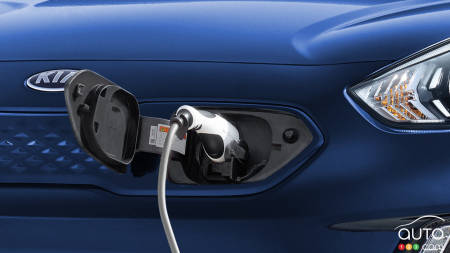Auto123 puts the Kia Niro EV to the long-term test. Today, part 11.
Contrary to the expectations I expressed at the end of my last chapter of this long-term review, the Kia Niro EV did not, in the end, require a lift at a brand dealership’s service centre for maintenance. EV-style maintenance, of course…
Indeed, after I brought up this concern of mine with the head of public relations for Kia in Quebec, Frédéric Tremblay did some checking with those in the know. Was my rush to get the Niro EV hoisted on a lift justified, or just a child-like desire of mine to see what it looked underneath?
Well it turns out it was more or less the latter. Kind of. First, Kia’s official explanation regarding the maintenance schedule for its all-electric models (the automaker’s 2022 electrified lineup includes two hybrids and two PHEVs – both the Niro and Sorento – as well as two BEVs, the Niro and Soul):
"Our EVs must be inspected by an authorized dealer (i.e. the staff of which has taken a specialized course on EVs) at least every 12 months or 12,000 km when the vehicle is used under normal conditions.”
(As opposed to, I guess, when it is used “abnormally”. Like, for instance, towing a 30-foot trailer when the Niro EV's maximum towing capacity is 1,300 kg or visiting a drag strip to try to outdo Kia’s official 0-100 km/h acceleration time of 7.8 seconds).
Well OK, but ...
As I mentioned last time, I was already at 19,000 km on the odometer. I had exceeded – nay, annihilated - the permitted 12,000 km between maintenance visits...
Except there was one important detail I had been unaware of: when Kia took the car back to put winter tires on it, just before the December 1st deadline imposed in Quebec, it took the opportunity to give the Niro a check-up. Just in case...
Frédéric explained to me that the inspection had not revealed anything suspicious. Therefore, I didn't have to worry about the odometer reading. Calm down, Mr. Columnist.

Yeah but, I’d kind of wanted to lift that Niro EV into the air!
That will be for another time, it seems.
Until then, I bombarded poor Frédéric with more questions.
One: Is it correct to say that a gasoline-powered vehicle requires more frequent maintenance than an EV?
The official answer: “Each model has its own maintenance intervals. We advise customers to follow the recommended schedule in the owner's manual for their specific model. ICE (Internal Combustion Engine) vehicles may require two to three services per year.”
Two: Okay. Is it safe to say that servicing an EV is faster and cheaper than servicing a combustion-engine vehicle?
“The average maintenance service for an EV versus an ICE vehicle takes about the same amount of time, and the costs may vary. The main difference is that an ICE will require oil changes and fuel system maintenance that are not required in a battery electric vehicle.”
Next, I wanted to address a persistent rumour, so...
Three: We hear that dealerships find it less cost-effective (so less profitable) to service EVs because they have fewer parts to change. Is this true or an urban legend?
“As we have seen, EVs require less frequent maintenance than ICEs, i.e. once a year versus 2-3 times a year respectively. Furthermore, although EVs have fewer parts (to check and/or change), their maintenance is very different from that of an ICE. As a result, costs can vary depending on the maintenance work required.”
You'll notice, as I did, that the manufacturer made like a good diplomat and did not claim that its dealerships make less of a profit when they service an EV. Nor they deny it. For my part, since an EV comes into the shop less often and has fewer parts that can be changed, it’s fairly safe to assume that an EV is indeed less profitable for the dealer to service.
Fortunately, there is the sale itself, with a hefty MSRP, alleviated by generous provincial subsidies. Both dealer and customer are happy.
That’s assuming, of course, that the dealer has EVs in stock...
Specifications sheet of KIA Niro EV

The priorities
Four: When an EV finally does show up at the dealership for maintenance, what are the technician's top three things to check?
“Among the checklist of items to inspect during a service visit, the technician will focus on the battery, fluids and brakes. These are important inspection points, not to mention the filter and tire condition.”
In fact, the first part of the EV that will likely require replacement is the air filter, probably around the 24,000 km mark.
One last thing regarding the question of maintenance visits: You can program the service parameters in the Niro EV's user interface according to the number of km or months that pass. Do that, and your trusty steed will tell you when it would like to have its hooves inspected.
Jolly Jumper couldn't do better!
See also: Kia Niro EV Long-Term Review, Part 1: The carmaker, the reviewer and the (young) enthusiast
See also: Kia Niro EV Long-Term Review, Part 2: Electric cars, a new idea with a long history
See also: Kia Niro EV Long-Term Review, Part 4: Getting a charge out of charging
See also: Kia Niro EV Long-Term Review, Part 5: Many kilometres, many questions
See also: Kia Niro EV Long-Term Review, Part 6: When the computer decides things, without consulting us
See also: Kia Niro EV Long-Term Review, Part 7: Off to Join the Electric Circuit
See also: Kia Niro EV Long-Term Review, Part 8: The Benediction
See also: Kia Niro EV Long-Term Review, Part 9: Beating the Cold
See also: Kia Niro EV Long-Term Review, Part 10: Let’s Talk Maintenance




